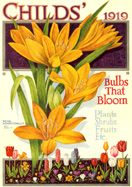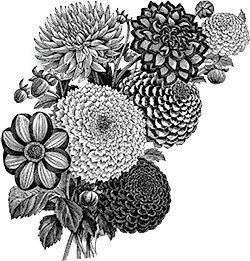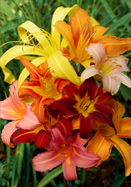Order these summer-planted bulbs NOW for delivery next July.
All bulbs for summer 2026 are SOLD OUT.
|
ARE DAYLILIES BULBS? Not really, but bulb catalogs in the past offered their thick, fleshy roots, and today many antique daylilies are at risk, so we’ve added them to our Ark. Modern daylilies can be amazing, but older ones blend better into most gardens. They’re not huge or gaudy, and their classic, lily-like forms are full of grace.
TIPS FOR SUCCESS: Daylilies are one of the easiest of all perennials. See what you’ll get: freshly dug, bare-root plants with 2-4 fans (growing points). Plant in full sun to light shade, and learn more here.
|
|
|
|
|
With cottage-garden grace and surprising diversity, antique daylilies are waiting to be rediscovered by modern gardeners. Sample their old-fashioned charms with 3 of our favorites, all different, labeled, and great for your area. (Several possibilities are pictured.) For zones 4a-8b(9aWC).
For more of each variety, order additional samplers. Daylily care. Summer shipped, click here for spring shipped.
|
|
|
|
Here’s the beginning of daylilies as we know them today. Introduced in 1893 by schoolteacher George Yeld, ‘Apricot’ was the first hybrid daylily and its success opened the door for the 60,000 others that have followed. Spring-blooming (starting in early May here in zone 6a) and often reblooming in the fall, it has vivid little flowers of orange-yellow peeking above a fountain of leaves — making it well worth growing even if it weren’t so historic. 28-34”, early, deciduous, zones 4a-8b(10aWC), from our own micro farms. Chart and care. Summer shipped, click here for spring shipped.
|
|
|
|
Tall, tall, TALL – with bloom stalks up to 7 feet! – this remarkable daylily may get you and your garden visitors babbling. Up close its spidery, gold and chestnut flowers are nothing special, but when you see them held high against the sky on their strong, slender stalks – often with hummingbirds flitting about – they’re magic. By A.B. Stout, from the wild H. altissima, 5-7’, late blooming, lightly fragrant, deciduous, 2-3 fans, zones 4a-8b(10aWC), from our own micro-farm. Chart and care. Summer shipped, click here for spring shipped.
|
|
|
|
Back in the day, ‘Black Falcon’ was celebrated as the darkest daylily of all, and 70 years later it’s still a stunner. A glowing center of molten gold makes its rippled, mahogany-red petals seem even darker. It’s free-flowering, easy-growing, mid-summer blooming, 32-36”, deciduous, 2-3 fans, for zones 4a-8b(10aWC), from our own micro-farm. Chart and care. Summer shipped, click here for spring shipped.
|
|
|
|
‘Caballero’s long, curling petals are gold and an intriguing rusty brown (yes, brown!) that may remind you of saddle-leather and sandstone buttes – which is probably just what Stout had in mind when he named it. Caballeros were the noble “gentlemen-cowboys” of popular movies such as The Bold Caballero of 1936 with its dashing hero, Zorro. 36-40”, early-mid season, evergreen, 2 large fans, zones 4a-9b(10bWC), from our own micro-farm. Chart and care. Summer shipped, click here for spring shipped.
|
|
|
|
This dramatically tall, colorful daylily will draw your eye from the farthest reaches of your garden. It gets its height – five feet or more here – from H. altissima, native to the mountains of Nanjing, and with 25-30 buds per stem, its striking red flowers will entertain you from mid-summer into fall. By A.B. Stout, 48-72”, deciduous, 2-3 fans, zones 4a-8b(10bWC), from our own micro-farm. Chart and care. Summer shipped, click here for spring shipped.
|
|
|
|
With charming, not-so-big flowers of a lemon yellow that’s both soft and bright, this rarely offered Depression-era beauty mingles easily with other perennials and adds a cooling note to the mid-summer garden. It was bred by the master A.B. Stout himself who liked it so well that he named it for Odysseus’s enchantress, the “loveliest of all immortals.” Long-blooming, 32-36”, mid-summer blooming, deciduous, 2-3 fans, zones 4a-8b(9bWC), from our own micro-farm. Chart and care. Summer shipped, click here for spring shipped.
|
|
|
|
True stock! Many daylilies are mistakenly called lemon lily, but ours is the true original. For centuries, this and the single orange “ditch lily” were the only daylilies common in gardens. Always the more prized, lemon lily is smaller, much more graceful, and early blooming, with a sweet scent that led one botanist in 1733 to call it the “Yellow Tuberose.” Best in cool climates and moist soils. We ship single fans of this great rarity. Formerly H. flava, 24-32”, deciduous, zones 3a-7a(9aWC), from our own micro-farm. Chart and care.
|
|
|
|
When we asked the experts, this pastel gem topped the list of heirloom daylilies we just had to offer. Its pale, melon-pink color was an exciting advance for the 1950s, and – enhanced by a cool green throat – it’s still exciting and lovely today. Winner of the Stout Medal, it was bred by Edna Spalding of rural Louisiana who grew her seedlings in the vegetable garden and culled the rejects with a kitchen knife. 32”, mid-summer blooming, deciduous, zones 4a-8b(10bWC), from Michigan. Chart and care. Summer shipped, click here for spring shipped.
|
|
|
|
This striking daylily was one of Stout’s first and favorite introductions. Over the years its bold mango-and-mahogany coloring and graceful star-like form have won it many fans, including the great Elizabeth Lawrence who praised it as one of her “15 Best.” Vigorously multiplying and floriferous, it often reblooms in the fall in warm areas. 30-36”, early-mid season, semi-evergreen, 2 fans, zones 4a-8a(10aWC), from our own micro-farm. Chart and care. Summer shipped, click here for spring shipped.
|
|
|
|
We’re thrilled to finally offer this dramatic beauty, after years of building up stock. It’s a deep raspberry-rose highlighted by an orange throat and ivory midrib lines that really make it pop. And its name? Artists may recognize it as the name of the color of the celebrated old rose ‘Paul Neyron’ of 1869. RHS AGM, 30-32”, mid, 2 fans, zones 4a-8a(10aWC), from our own micro-farm. Chart and care. Summer shipped, click here for spring shipped.
|
|
|
|
We can’t understand why everyone isn’t growing this great little daylily. It blooms remarkably early – with the first bearded iris of May – and profusely, even in the half-shade of our old grape arbor. Its graceful, star-like flowers are a cheery yellow-orange that’s somewhere between mangoes and California poppies. And it’s one of the oldest survivors from the very dawn of daylily breeding, by school teacher George Yeld. 24-30”, deciduous, zones 4a-8b(9bWC), from our own micro-farm. Chart and care. Summer shipped, click here for spring shipped.
|
|
|
|
We love how profusely this charming little daylily blooms, and how its small, rusty red flowers glow warmly in the summer sun. Bred by the great A.B. Stout, it was named by globe-trotting “lady botanist” Mary Gibson Henry in memory of her youngest son, Porteous. 26-32”, early-mid to mid, semi-evergreen, zones 4a-8a(10aWC), from our own micro-farm. Chart and care. Summer shipped, click here for spring shipped.
|
|
|
|
With its red-violet undertones, this Stout Medal winner was an exciting color advance for its time, and although no one today would describe it as “pansy purple,” it’s still a striking flower. And potent – it often develops small plantlets called proliferations on its bloom stalks which you can root and grow into new plants! 36-42”, mid to late-mid, deciduous, 2-3 fans, zones 4a-8a(10aWC), from our own micro-farm. Chart, care, and learn more. Summer shipped, click here for spring shipped.
|
|
|
|
One of the latest, longest-blooming, and brightest daylilies we grow, ‘Princess Irene’ will draw you from across the garden with its joyful brilliance, from mid-summer well into fall. With its star-like form and almost wriggling petals, it’s the only daylily ever introduced by H. A. Zager of Des Moines – but he sure picked a winner. 28-34”, late-mid to late, deciduous, 2 fans, zones 4a-8a(10aWC), from our Ann Arbor micro-farm. Chart and care. Summer shipped, click here for spring shipped.
|
|
|
|
60 years ago this tall, dark-red/burgundy daylily caused ripples with its long elegant petals and vigorous growth. It contrasts beautifully with yellow and gold neighbors and can rebloom throughout the summer. 36”, early-mid, 2-3 fans, zones 4a-8b(10bWC), from our own micro-farm. Chart and care. Summer shipped, click here for spring shipped.
|
|
|
|
Stout-award-winner ‘Revolute’ boasts large, graceful lemon-yellow flowers that are not only fragrant but stay open over 12 hours for evening enjoyment! A lovely drought-resistant legacy of Nebraskan Hans Sass. 36-42”, mid-late, zones 4a-8b(10aWC), from Michigan. Chart and care. Summer shipped, click here for spring shipped.
|
|
|
|
One of the most famous daylilies of all, this wild beauty was the best of the three reddish forms of Hemerocallis fulva sent to A.B. Stout from China in 1924 – and which Stout used to breed the very first of the thousands of pink, red, and purple daylilies that have graced gardens ever since then. Rusty red with a darker eye-zone, 38-42”, late-mid, dormant, 2 large fans, zones 4a-8a(10aWC), from our own micro-farm. Chart, care, and learn more. Summer shipped, click here for spring shipped.
|
|
|
|
Bred by Ophelia “Bright” Taylor, winner of the AHS’s highest award for hybridizers, this purple-shaded, wine-colored daylily has slender petals curling back gracefully from a vivid yellow throat. It’s been a favorite oldie of our Missouri growers for over 40 years thanks to its “rich color, recurved petals, and beautiful foliage.” 32-36”, mid-season, semi-evergreen, 2-3 fans, zones 5a-9a(10aWC), from our own micro-farm. Chart and care. Summer shipped, click here for spring shipped.
|
|
|
|
This rarely offered, landmark daylily was bred by A.B. Stout, the New York Botanic Garden scientist who unlocked the amazing potential of daylilies, setting them on the road to superstardom. Although Stout introduced 92 remarkable daylilies, he’s said to have been especially proud of ‘Theron’, whose mahogany blooms made it the first “red” daylily. 30”, early-mid blooming, deciduous, 2-3 fans, zones 4a-8b(9bWC), from our own micro-farm. Chart and care. Summer shipped, click here for spring shipped.
|
|
|
|
One of the oldest daylilies of all, and very hard to find today. This lightly fragrant beauty came from a clump growing in OHG founder Scott’s front yard – until we dug it up to share with you. (No problem!) It was bred by R. Wallace and Co., importers of some of the first daylilies from China, and praised in the June 1900 Country Life as “a Day Lily of great beauty, vigorous and handsome.” 28-32”, early-mid, deciduous, 2 fans, zones 5a-8a(10aWC), from our own micro-farm.
Chart and care.
Last offered in 2025. If you’d like to be notified when it’s back in stock, click to sign up for an email alert.
Summer shipped, click here for spring shipped.
|
|
|
|
What sets this mighty classic apart — and why should you give it a try? It’s more fragrant than its famous parent ‘Hyperion’. Its Chicago breeding makes it extra tough. And its lily-like, moonlight-yellow flowers stay open longer than most, making it especially beautiful in the evening garden — when you’ll be home to enjoy it. 36” mid-summer blooming, deciduous, zones 4a-8b(9aWC), from our own micro-farm.
Chart and care.
Last offered in 2025. If you’d like to be notified when it’s back in stock, click to sign up for an email alert.
|
|



































